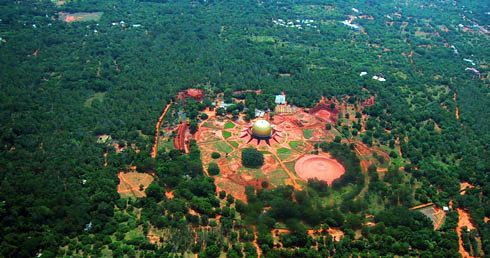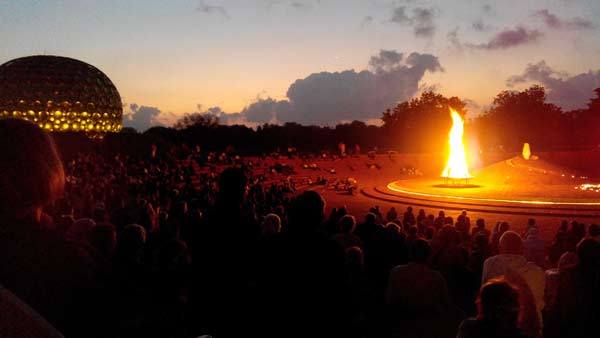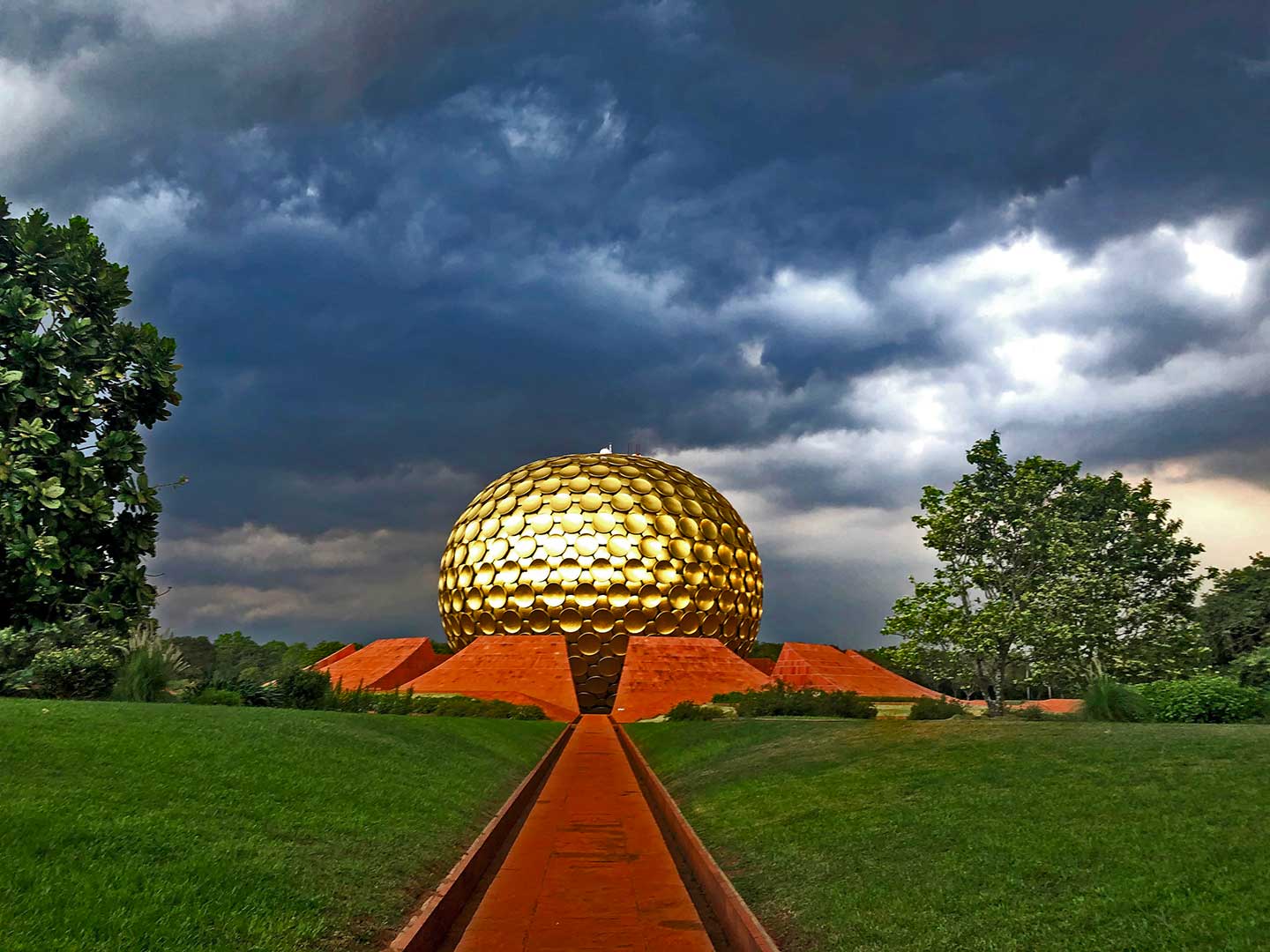Last updated:
Land and Nature

Auroville, as does India, hosts an abundance of natural contrasts. Details of land work and reforestation already done here abound in Auroville literature. But any visitor to this land can see for him/herself the fruits of those labours, and someone visiting for the first time may be struck by a few salient physical features.
Ever-present red laterite earth..
Auroville is located on a plateau some 50 mts above sea level. Ignoring the gentle slope up from the sea all the way to the Matrimandir, and a number of erosion features, the land is essentially flat in the sense that it is without any hills or escarpments. Rainwater running in streams across the ground betrays otherwise unnoticeable subtle grades. Over time these streams have cut deep grooves into the earth on their journey to the Bay of Bengal. Carrying topsoil away, they have left several canyons within Auroville. Multihued in whites, reds and browns, comprised of sand, pebbles and the ever-present red laterite earth, home to many birds and small animals, reptiles and insects, these heavily eroded areas are slowly being reclaimed by the forests; many trees can now be found growing in Forecomers and Utility canyons.
Auroville woods
From the insistent and repetitive cry of the 'brainfever' bird (common hawk cuckoo, Cuculus varius Vahl) to the milder chirping of varied small songbirds, forests across Auroville resound with clear melody. Occasional thickets of mature green and yellow bamboo reach toward the sky and sway in the ocean breeze.
Bamboo stalks with their fine leaves have inspired many master artists; they breathe elegance and grace of form.
The 'work' tree (Mother's name for Acacia auriculiformis), native to Australia but introduced in Auroville in the early years, has made a bold attempt to dominate the local habitat. It has been widely used in carpentry and construction. I sit writing at a work tree desk, its figured grain shining under varnish in golden and mahogany hues.
Giant banyan trees, found in tropical climes, form vast, arching tents; aerial roots descend from upper branches seeking earth. Thick, twisting limbs support sturdy green leaves. Stippling their vermilion canopies, red cherry-like seeds grow, and attract flocks of crows, parrots and mynahs by day, followed by huge flying fox fruit bats at night.
Fences of thorn branches and a local cactus resembling ferocious aloe vera work to ward off encroaching goats, cows and firewood gatherers from nearby villages.
Thriving villages
Kottakarai, Edayanchavadi and Kuilapalayam are the main villages which thrive within the perimeter of Auroville. Kuilapalayam, situated on the main road heading toward the beach and Pondy, has become quite affluent through daily trade with Aurovilians. It boasts a row of prospering shops lining the road, and several newly built or renovated little temples, colourful with brightly painted icons of Kali, Ganesh and Durga. With the lifting of restrictions on foreign trade, western goods are found in increasing abundance in India, including in Kuilapalayam. Although rumour has it that Chennai taxi drivers speak of Kuilapalayam the way we speak of 'Timbuktoo', it is not truly such an outpost of civilisation. Leatherman multi-tools, blank CDs, Marlboro cigarettes and cell phones can be had not far from a local idli/vadai restaurant and fruit vendors are displaying colourful piles of coconuts, pineapples, papayas, bananas and varied vegetables.
Roads and traffic
The local roads have either improved or deteriorated, depending on how you see it. Change seems inevitable. While they used to consist of dusty dirt tracks, today a prominent tar road winds through a major section of Auroville. Flanked by cashew topes, cyclists on this road are subjected to the hazards of increasing motorised traffic, especially of the four-wheeled variety. Although the roads of urban India are incomparably worse in terms of danger and population density, in Auroville a growing number of lorries, buses, taxis and vans, as well as private cars, bear down on smaller traffic. Horns blaring, exhaust and dust combining in mini-storms, often they race by, local labourers staring from the backs of trucks, film music pumping forth from car interiors. The omnipresent motorcyclists, inhabitants of Auroville, sun-glassed and mostly well-dressed, edge impatiently around these larger vehicles and vanish, leaving only the echoing scream of engine sound, and perhaps the memory of an acknowledging nod or smile. One may also notice bullock carts and tractors on these roads, some trailing noxious loads.
Compounding the health threat posed by dust and exhaust, the habit of yearly pesticide spraying of the cashew trees by the local villagers leaves many an Aurovilian and Tamil villager sick with cough, running nose, sore throat or burning eyes.
Other roads have retained their rustic qualities, dirt tracks still, wending through shady forested areas replete with crystalline birdsong.
Life at the beach
Auroville lies on the 'Coromandel Coast'. Here the Bay of Bengal hosts regular swimmers, avid surfers, and weekly sunbathers. Coconut palms are separated at Repos, a beach community, from the water's edge by a large expanse of sand, too hot to walk on in the midday sun. Auroville beach access points lie between local fishing villages. Fishermen rise well before dawn, and can be seen offshore standing on their palm tree canoes. In the distance against the sunrise they appear to walk on the water. Dawn at the seaside also witnesses the morning ablutions of these fishing communities, which conveniently get washed into the sea.
Lakes and kolams
There are a few lakes around Auroville, Kaliveli Tank and the lake at Lake Estate being the main ones. Freshwater bodies within Auroville are found in kolams, and in the small dam in Aurodam. Large craters, kolams fill during the monsoons, and serve as watering holes for animals, bathing and washing places for villagers, and containments to hold water until it can seep back into the aquifer.
Kolams present differing faces: from a GreenBelt kolam rise the stark, branchless black trunks of Palmyra trees, while, when the water level has sunk, the Kuilapalayam tank clothes itself in hundreds of exquisite lotuses growing from its muddy depths.






